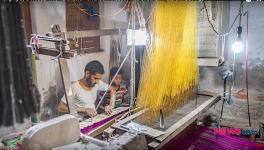Dipping Earnings, Rising Costs: Weavers of Bihar’s ‘Silk City’ Fight for Survival
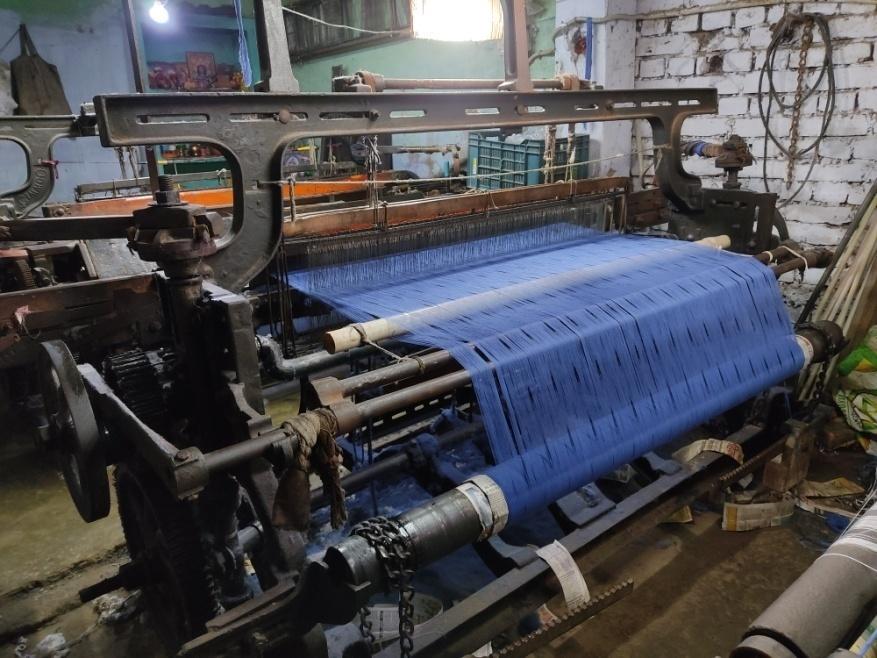
A powerloom in Nathnagar, Bhagalpur
The government’s slogans of ‘Vocal for Local’ and ‘Aatma Nirbhar Bharat Abhiyan’ seem to be mocking Bihar’s ‘Silk City’, Bhagalpur, which is home to thousands of weavers. Bhagalpur is losing its sheen every day as its old weaver community battle an existential crisis.
Amid absence of government help or intervention, numerous challenges like loss-making silk business, costlier raw material, cheap sale of hand-made fabric, and inflated prices of yarn have put weavers in a fix over whether to continue weaving in an abysmal condition or quit the age-old profession.
Inflated Cotton Yarn Price
Inflated price of cotton yarn is the latest to hit the crumbling silk and other fabric industries. Ikkat, a cotton variety used to make curtain, kurta, salwar that have high demand in the local market, is no more a choice for weavers. Approximately an order of cotton yarn worth Rs 50 crore was not received by the weavers of Bhagalpur as a gesture of their dissatisfaction due to the increase in the price of yarn. The cost of per kilogram of cotton yarn has risen from Rs 300 to Rs 450 making it costlier for the weavers to purchase and work with the material.
The price rise has hindered manufacture of cotton-tussar silk-blended garments. For example, a tippet worth Rs 100 now costs Rs 140, a bed sheet worth Rs 300 has gone up to Rs 360, which has decreased their production by the weavers. According to Alim Ansari, secretary of Resham Bunkar Khadi Gramodyog Sangh (RBKGS), the production of cotton products such as lungi, shirt, gamchcha etc. have dipped very low and the sole reason behind it is costly yarn.
Moreover, cotton yarn used for making designs on silk garments has also been hit even though it is a small task in comparison to making a complete cotton garment. Silk garments with cotton yarn design have become costlier due to the price rise of this small component. Silk price per kilogram used to be Rs 3,000, which has now climbed to Rs 7,000, while the earning of weavers remains the same. The raw material expenditure of Rs 2,000 in making a silk saree with cotton blend has risen to Rs 2,500, and selling them at former rates to big retailers and businessmen is no more a possibility.
Price rise of yarn is a result of there being no yarn bank in Bhagalpur under the Yarn Supply Scheme (YSS). Because of the absence of any yarn bank, the open markets are still enjoying the monopoly and earning huge profits. The market’s monopoly and arbitrary price rise has directly affected the poor weavers. Without a yarn bank, yarn supply comes to Bhagalpur from Chennai, Kolkata and the cocoon is purchased from Jharkhand and Uttarakhand. The tedious and tiring process of yarn availability thus continues. A yarn bank as promised by the National Handloom Development Corporation (NHDC) remains unfulfilled after a decade of the announcement. Alim Ansari claimed to have also requested the state government to set up a yarn bank to ease the discomfort of weavers, which he says has fallen on deaf ears.
The annual business of Bhagalpur silk industry now amounts to around Rs 100 crore but it used to be Rs 600 crore.
The popularity of Bhagalpur silk industry is due to its much acclaimed ‘tussar silk’ that enjoys a world reputation. However, this does not seem to fit in the ‘Aatma Nirbhar Bharat’ scheme due to the deteriorating condition of weavers across the state. The localised industry is left in the lurch and at the mercy of state and central governments who have merely delivered rhetoric in name of revival of the industry. The schemes floated by the Ministry of Textiles with respect to weavers include the National Handloom Development Programme (NHDP), Comprehensive Handloom Cluster Development Scheme (CHCDS), and Handloom Weavers’ Comprehensive Welfare Scheme (HWCWS), but minimum benefits have reached the target.
Painful Saga of Weavers
A labyrinthine complexity persists in the government policies targeted at the weavers. In the case of Kalicharan (38), a weaver based in Maskan Bararipur, Nathnagar, he undertook a three-day training under the Prime Minister’s Kaushal Vikas Yojana (PMKVY) scheme in 2019 but ended up learning no new technique or skill. He said, “I am weaving fabric for 20 years and was hopeful after the outreach of the PMKVY scheme, but it was a huge disappointment as the trainers did not mention anything new. We received a t-shirt, a certificate and no knowledge. Handing over recognition is not enough to overcome low monthly earnings.”
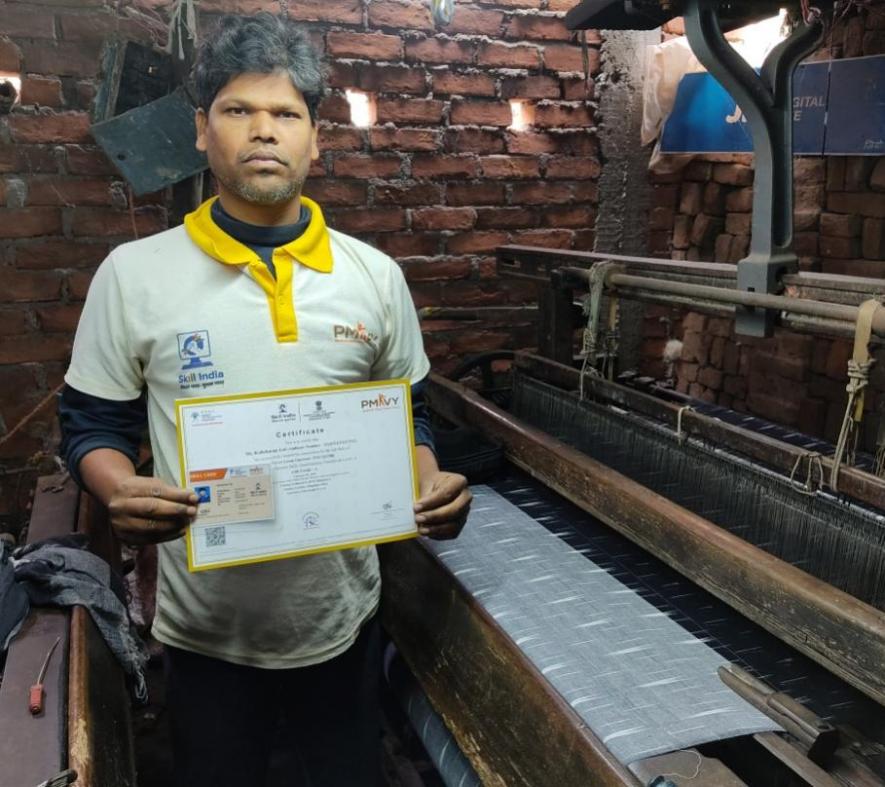
Pic: Kalicharan, a weaver trained by PMKVY
“I urge the government to provide us ‘Rapier’ machines that would enable us to weave more fabric length-wise in a day. At present, only 30 metres is the limit while the rapier can enhance it to 200 metres per day. Our concerns of low income can genuinely be answered if the government provides us the same,” added Kalicharan.
The city has a Weaver’s Service Centre (WSC) that is meant to impart training to semi-skilled and skilled handloom weavers for product development, diversification and improvement. However, the silk hub is presently home to powerlooms and the WSC’s existence does not add any benefits to the community.
Bhagalpur has the largest cluster of weavers i.e. nearly 60,000, after Gaya and Banka. In an exception, the ‘tanti’ or weaver community (Scheduled Caste) is among the lower castes who are aloof from agriculture and land holdings of any kind while being solely dependent on the painstaking job of weaving.
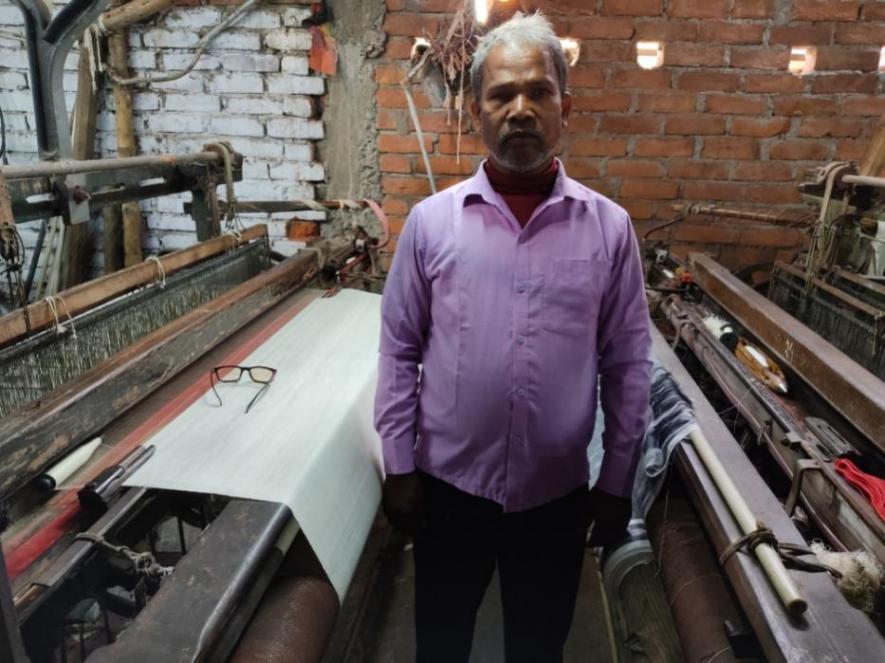
Pic: Manohar Lal
Weaving charge of Rs 9 per metre for weavers has dipped to Rs 5 per metre while inflated price of yarn at Rs 150 per kilogram has pushed the community towards an unprofitable business. “The sky-rocketing yarn price has hit our dwindling existence,” said Manohar Lal (50). Manohar lost his right eyesight after a pointed shuttle flung out of a powerloom and hit his eyes during his teenage. The damaged eye and hard lives of weavers point to a hopeless future, Manohar said, adding that the soaring yarn price is a result of systemic exploitation unleashed on them by big yarn traders.
Amid sounds of thousands powerlooms running day and night, the livelihood concerns and complaints of weavers fail to reach government officials and administration. Talking to NewsClick, former Industries minister of the state, Shyam Rajak said, “Bunkars (weavers) in Bihar are surviving somehow and are in desperate need of the government’s helping hand such as waiving off electricity charges pending since long. The worsening economic condition is inhibiting them from taking a leap,”
“During my tenure, initiatives like popularising the silk industry and subsidies were floated and a strong demand was made to the Centre for granting special status to Bihar and that could have rescued the teetering silk industry,” said Rajak. He also stressed on an immediate makeover of the Bhagalpur airport to promote the silk industry and ensure product outflow with an aim to directly benefit weavers so that the labour-intensive traditional industry could overcome its waning fate.
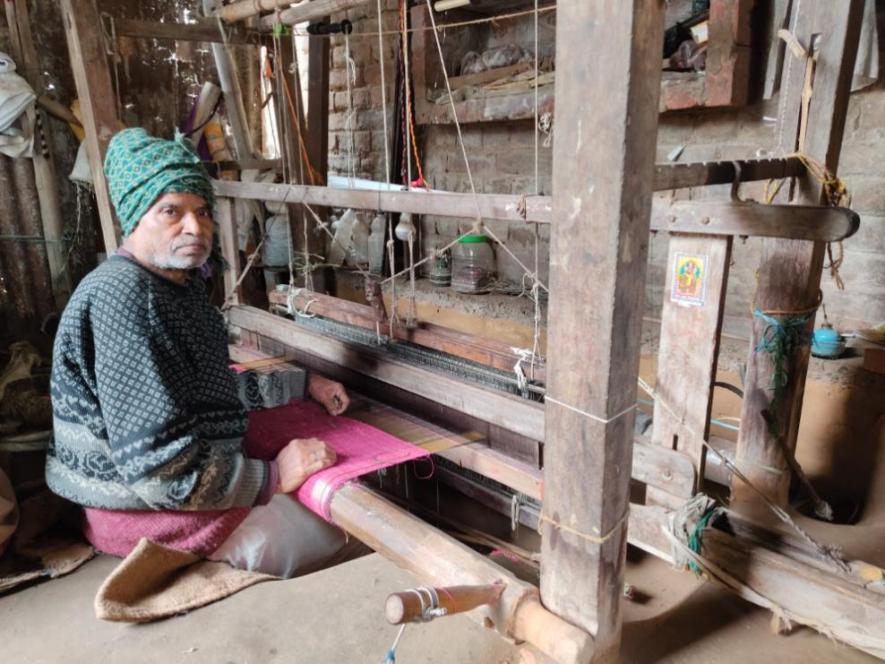
Pic: Bindu Das, a lone handloom weaver
The erstwhile paradise of ‘Tussar Silk’ is in grip of abject poverty, as depicted by the status of Bindu Das (70). The septuagenarian weaver uses handloom, merely earning Rs 100 for weaving two fabrics. On the verge of extinction, the handloom is not in government’s priority list while it is a soft target for big traders who pay less to weavers and sell by doubling the rate in market, remarked Das.
The household occupation of weaving is spread across a three-km radius in two pockets of Nathnagar and Champanagar in Bhagalpur city and it shows the deep economic roots of thousands of families. Many of these weaver families reiterated that the COVID-19 induced lockdown acted as a sledgehammer that hit and damaged 95% of the business.
Silk Industry and Social Contract
Bhagalpur silk industry’s story is inextricably linked to the identity of the craftsmen involved in weaving and belong to both Muslim and Hindu (Tanti, Schedule castes) communities. Nathanagar and Champanagar areas comprise weaving clusters on both sides of narrow lanes emerging from the city.
As per Mohammed Shamshad (45), who runs one of the largest weaving units with 25 powerlooms, imagining the silk city without religious cohesion will be a mistake because the whole process of weaving, bleaching, dyeing, and drafting to trading involves work exchange between Hindus and Muslims. Despite the dwindling status of weavers, social harmony and economic exchanges are realities of contemporary times when communal tension is on rise and city has memories of the 1989 communal riots.
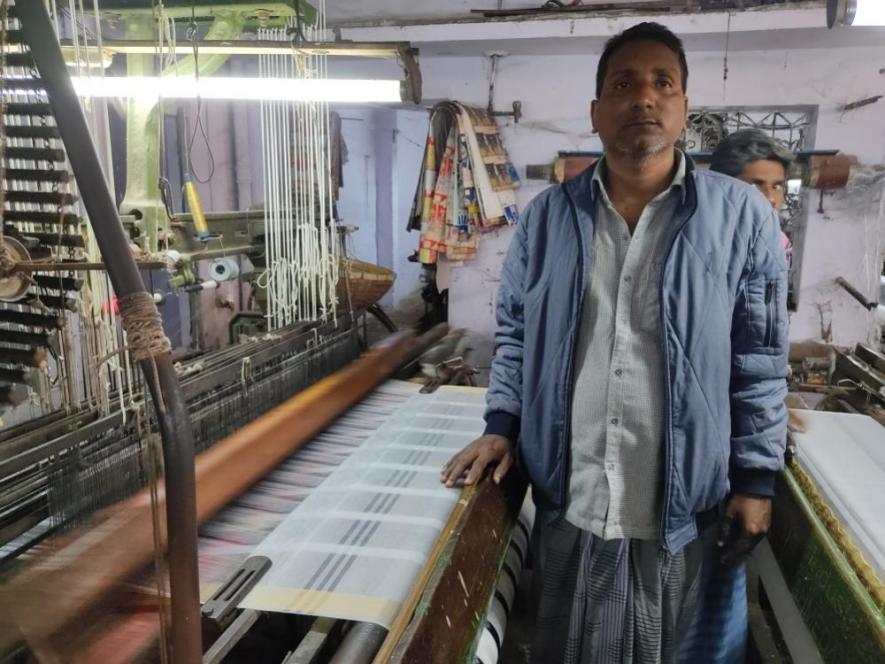
Pic: Md. Shamshad
Shamshad stressed that not much assistance has been forthcoming from the government to shore up the craft, which is recognised across the world. “If serious efforts are to be made then we demand setting up of a government outlet as fabric purchase and sell corridor dedicated to the weaving community and this would bypass the orchestrated exploitation at hands of large businessmen and traders,” he said.
Shamshad’s grievances are echoed by Md Zubair (55) who feels a weaver has to face immense difficulty right from purchasing raw material to manufacturing silk items. Post-manufacturing, a weaver has to face difficulties in selling his product in the right market.
Get the latest reports & analysis with people's perspective on Protests, movements & deep analytical videos, discussions of the current affairs in your Telegram app. Subscribe to NewsClick's Telegram channel & get Real-Time updates on stories, as they get published on our website.


















